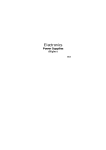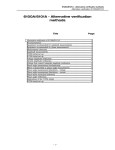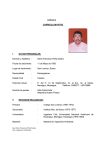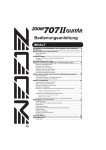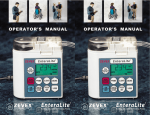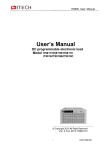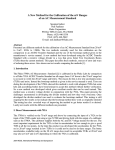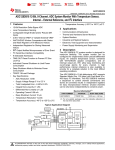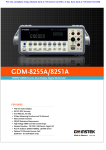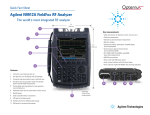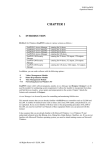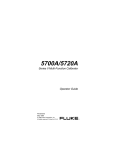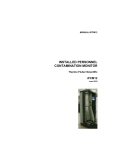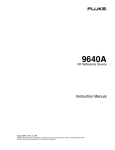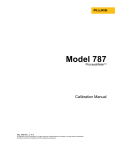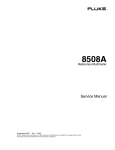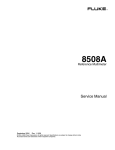Download Instruction Manual
Transcript
A40B Precision AC Current Shunt Set Instruction Manual July 2008 Rev. 1, 7/09 © 2008-2009 Fluke Corporation. All rights reserved. Specifications are subject to change without notice. All product names are trademarks of their respective companies. LIMITED WARRANTY AND LIMITATION OF LIABILITY Each Fluke product is warranted to be free from defects in material and workmanship under normal use and service. The warranty period is one year and begins on the date of shipment. Parts, product repairs, and services are warranted for 90 days. This warranty extends only to the original buyer or end-user customer of a Fluke authorized reseller, and does not apply to fuses, disposable batteries, or to any product which, in Fluke's opinion, has been misused, altered, neglected, contaminated, or damaged by accident or abnormal conditions of operation or handling. Fluke warrants that software will operate substantially in accordance with its functional specifications for 90 days and that it has been properly recorded on non-defective media. Fluke does not warrant that software will be error free or operate without interruption. Fluke authorized resellers shall extend this warranty on new and unused products to end-user customers only but have no authority to extend a greater or different warranty on behalf of Fluke. Warranty support is available only if product is purchased through a Fluke authorized sales outlet or Buyer has paid the applicable international price. Fluke reserves the right to invoice Buyer for importation costs of repair/replacement parts when product purchased in one country is submitted for repair in another country. Fluke's warranty obligation is limited, at Fluke's option, to refund of the purchase price, free of charge repair, or replacement of a defective product which is returned to a Fluke authorized service center within the warranty period. To obtain warranty service, contact your nearest Fluke authorized service center to obtain return authorization information, then send the product to that service center, with a description of the difficulty, postage and insurance prepaid (FOB Destination). Fluke assumes no risk for damage in transit. Following warranty repair, the product will be returned to Buyer, transportation prepaid (FOB Destination). If Fluke determines that failure was caused by neglect, misuse, contamination, alteration, accident, or abnormal condition of operation or handling, including overvoltage failures caused by use outside the product’s specified rating, or normal wear and tear of mechanical components, Fluke will provide an estimate of repair costs and obtain authorization before commencing the work. Following repair, the product will be returned to the Buyer transportation prepaid and the Buyer will be billed for the repair and return transportation charges (FOB Shipping Point). THIS WARRANTY IS BUYER'S SOLE AND EXCLUSIVE REMEDY AND IS IN LIEU OF ALL OTHER WARRANTIES, EXPRESS OR IMPLIED, INCLUDING BUT NOT LIMITED TO ANY IMPLIED WARRANTY OF MERCHANTABILITY OR FITNESS FOR A PARTICULAR PURPOSE. FLUKE SHALL NOT BE LIABLE FOR ANY SPECIAL, INDIRECT, INCIDENTAL, OR CONSEQUENTIAL DAMAGES OR LOSSES, INCLUDING LOSS OF DATA, ARISING FROM ANY CAUSE OR THEORY. Since some countries or states do not allow limitation of the term of an implied warranty, or exclusion or limitation of incidental or consequential damages, the limitations and exclusions of this warranty may not apply to every buyer. If any provision of this Warranty is held invalid or unenforceable by a court or other decision-maker of competent jurisdiction, such holding will not affect the validity or enforceability of any other provision. Fluke Corporation P.O. Box 9090 Everett, WA 98206-9090 U.S.A. Fluke Europe B.V. P.O. Box 1186 5602 BD Eindhoven The Netherlands 11/99 To register your product online, visit http://register.fluke.com Table of Contents Title Page Introduction and Specifications ......................................................................... About the Manual .......................................................................................... Safety Information......................................................................................... General Safety Summary .......................................................................... Symbols..................................................................................................... Product Description ....................................................................................... Electrical Specifications .................................................................................... Current Shunt Absolute Accuracy................................................................. Resistance Specifications .............................................................................. Maximum AC-DC Difference ....................................................................... Maximum Overload Current ......................................................................... Typical Phase Displacement.......................................................................... General Specifications ....................................................................................... Dimensions (maximum) ................................................................................ Physical/Mechanical Parameters ................................................................... Operating Environment ................................................................................. Storage and Transit Environments (for models other than the 1 mA Current Shunt)........................................ Additional 1 mA Current Shunt Specifications ............................................. Preparing for Operation ..................................................................................... Unpacking and Inspecting the Shunts ........................................................... Accessories .................................................................................................... Table.......................................................................................................... Contacting Fluke ........................................................................................... Shipping Information..................................................................................... Storage Information....................................................................................... Acceptance Test............................................................................................. General Maintenance/Cleaning ..................................................................... Operating Information ....................................................................................... Feature Descriptions...................................................................................... Input/Output Connectors ............................................................................... Maximum Current ......................................................................................... Operating Environment ................................................................................. Correcting for Current Shunt Error Contributions ........................................ Output Voltage Measurement – Loading Effect............................................ Output Voltage Measurement Using a Fluke 5790A .................................... i 1 1 1 1 2 3 4 4 5 6 6 6 7 7 7 7 7 7 8 8 8 8 9 9 9 9 10 10 10 12 13 13 13 14 14 A40B Instruction Manual Output Voltage Measurement Using a Fluke 8508A .................................... Operating Instructions........................................................................................ Introduction ................................................................................................... Measuring Current......................................................................................... Direct Read-out When Measuring Current.................................................... Theory of Operation........................................................................................... Coaxial Shunts............................................................................................... Boxed Shunts................................................................................................. Introduction ................................................................................................... An Overview of Calibration Methods ........................................................... Potential Voltage Measurement Devices .................................................. DC Considerations .................................................................................... AC Considerations .................................................................................... The Fluke Calibration Method ...................................................................... Recommended Tools and Equipment ....................................................... System Calibration for AC-DC Difference ............................................... TVC Sensitivity Characterization ............................................................. UUT AC-DC Difference Measurement Sequence and Calculations ........ Current Source DC Noise.......................................................................... UUT DC Resistance Measurement ........................................................... Repair Procedures Including Disassembly and Reassembly ............................. Repair Limits ................................................................................................. List of Tools Required for Repair.................................................................. End Plates and Guard Binding Post Replacement (Coaxial Shunts) ............. Input N-type Connector Replacement (Coaxial Shunts) ............................... Output N-Type Connector Replacement (Coaxial Shunts) ........................... List of Replaceable Parts ................................................................................... ii 15 16 16 16 18 18 18 19 20 20 21 22 23 24 25 25 26 27 28 28 29 29 29 30 31 32 33 List of Tables Table 1. 2. 3. 4. 5. 6. 7. 8. 9. 10. 11. 12. 13. Title Contents of the Current Shunt Set Packaging ........................................................ A40B Accessories .................................................................................................. Features and Connectors ........................................................................................ Typical Loading Effect of a 5790A, 2.2 V Range.................................................. Typical Loading Effect of an 8508A 2 V ACV Range .......................................... Estimating the Uncertainty of a 5790A Measurement ........................................... Sample Calculation of Measured Current .............................................................. Single Junction Thermal Voltage Converters ........................................................ Fluke 792A AC/DC Transfer Standard .................................................................. Fluke 5790A Measurement Standard ..................................................................... Other Error Sources and Solutions......................................................................... List of Recommended Equipment.......................................................................... Final Assembly....................................................................................................... iii Page 8 8 12 14 15 17 17 21 21 22 23 25 33 A40B Instruction Manual iv List of Figures Figure Title Page 1. 2. 3. 4. 5. 6. 7. 8. 9. 10. 11. 12. 13. 14. Current Shunt Configurations ................................................................................ Features and Connectors ........................................................................................ Loading Effect of the Measurement Device........................................................... Current Shunt - Simplified Electrical Diagram...................................................... Circuit Using a Reference Shunt Resistor to Determine Source Current............... Sources of Error in AC Measurements .................................................................. The Fluke Calibration System................................................................................ Calibrating Gain Difference ................................................................................... Characterizing Sensitivity ...................................................................................... AC/DC Difference Sequence ................................................................................. Exploded View of a Shunt ..................................................................................... N Type Input Current Connector ........................................................................... Output Voltage Connector ..................................................................................... Final Assembly – Typical Current Shunt from the Set .......................................... 3 11 14 19 20 23 24 25 26 27 30 31 32 33 v A40B Instruction Manual vi Introduction and Specifications About the Manual This is the Instruction Manual for the A40B Precision AC Current Shunt Set (hereafter referred to as the Current Shunt or Current Shunts). It contains all of the information a Calibration Technician needs to operate and maintain the Current Shunts. The manual is divided into the following sections: • • • • • Introduction and Specifications Preparing for Operation Operation Instructions Theory of Operation Service Instructions Safety Information This section addresses safety considerations and describes symbols that may appear either in this manual or on the Current Shunts. A W Caution statement identifies conditions or practices that could result in damage to the Current Shunts or equipment to which it is connected. A XW Warning statement identifies conditions or practices that could result in injury or death. XW Warning To avoid electric shock, personal injury, or death, carefully read the information under General Safety Summary before attempting to install, use, or service the Current Shunts. General Safety Summary This manual contains information and warnings that must be observed to keep the Current Shunts in a safe condition and ensure safe operation. Using or servicing the Current Shunts in conditions other than as specified in the Instruction Manual could compromise your safety. To use the Current Shunts correctly and safely, read and follow the precautions on the next few pages, as well as, the safety instructions or warnings given throughout this manual. In addition, follow all generally accepted safety practices and procedures when working with and around electricity. 1 A40B Instruction Manual XW Warning To avoid electric shock, personal injury, fire, or death, read the following warnings before using the Current Shunts: • Use the Current Shunts only as specified in this manual. • To avoid damage to eyes, skin, and the respiratory system, do not significantly exceed the maximum current rating of a shunt. Doing so may cause tracks on the printed circuit boards to vaporize. (See Maximum Overload Current in the Electrical Specifications.) • Do not use the Current Shunts in wet environments. • Inspect each Current Shunt before using it. Do not use the Current Shunt if it appears damaged. • Do not use a Current Shunt if it operates abnormally. If in doubt, have the Current Shunt serviced. • Have the Current Shunts serviced only by qualified service personnel. • Do not use the Current Shunts with voltages above 30 V ac rms, 42 V ac peak, or 42 V dc. These voltages pose a shock hazard. • When servicing the Current Shunts, use only specified replacement parts. • Do not dispose of batteries in fire. Do not heat, deform, solder, dissemble or modify the batteries • If batteries are removed from the shunt, ensure they are re-inserted with the correct polarity. • Use only the battery charger provided to charge the 1 mA active shunt. • Always connect the Battery Charger / Power Adapter to the AC outlet before connecting it to the shunt. • When replacing the batteries, replace them all together. Use only Nickel Metal Hydride (NiMH) batteries. • Do not operate the batteries together with other types of batteries, or batteries with different charge levels. • The batteries in the 1 mA Current Shunt are always connected to the charging socket, even when the Current Shunt is turned off. Symbols The following safety and electrical symbols may appear on the Current Shunt or in this manual. W F O I 2 Risk of danger. Important information. See manual. ~ Do not dispose of this product as unsorted municipal waste. Go to Fluke’s website for recycling information. DC (Direct Current) : Warning. Hot or burn hazard Power Off setting < Recycle Power on setting J Earth ground Precision AC Current Shunt Set Introduction and Specifications Product Description The A40B Precision AC Current Shunt Set consists of 14 Current Shunts, a complement of adapters, and a rugged transit/storage case. The Current Shunts are designed for laboratory use in making AC-DC current measurements or absolute AC or DC current measurements. They exhibit outstanding resistance value stability, excellent self-heating power coefficient, and a low temperature coefficient. Five configurations of Current Shunts comprise the set. They are as follows: • • • • • One boxed active shunt Three boxed passive shunts Five small size coaxial shunts Three medium size coaxial shunts Two large size coaxial shunts 1 mA 10 mA, 20 mA 50 mA 100 mA, 200 mA, 500 mA, 1 A, 2 A 5A, 10 A, 20 A 50 A, 100 A The physical construction and the components used in the Current Shunts ensure that amplitude displacement (error relative to DC resistance) and phase displacement at 100 kHz are small enough to be neglected in all but the highest accuracy measurements. Voltage output is nominally 0.8 V for nominal current input. The 1 mA boxed active Current Shunt is shown in Figure 1. t Inpu t Inpu t Inpu Figure 1. Current Shunt Configurations fim002.eps 3 A40B Instruction Manual Electrical Specifications Current Shunt Absolute Accuracy The following table shows the 1-year absolute accuracy specification stated at k=2, approximately 95% confidence for the calibrated value. The specifications include 1-year stability, temperature effects over TCal ± 1 °C, and the measurement uncertainty of the calibrated value. Shunt Nominal Current Nominal Resistance (Ohms) Specification ±μA/A, TCal ±1 °C, ≤50% RH [1][2][3][5] DC 1 kHz 10 kHz 30 kHz 100 kHz 800 20 55 75 75 150 10 mA 80 20 26 26 26 26 20 mA 40 20 26 26 26 26 50 mA 16 20 23 23 23 23 100 mA 8 20 24 24 24 24 200 mA 4 20 26 26 26 26 500 mA 1.6 21 27 27 27 28 1A 0.8 21 27 28 28 31 2A 0.4 21 27 30 30 48 5A 0.16 21 31 32 40 71 10 A 0.08 26 37 60 61 92 20 A 0.04 26 43 52 70 113 50 A 0.016 32 55 80 81 144 100 A 0.008 35 65 90 98 174 1 mA [1] [2] [4] The measured current is determined from: I = (V /Rcalibrated) × (1 + (AC-DCcalibrated / 1,000,000)); where AC-DCcalibrated is expressed in ppm Above 1 kHz interpolate the specification (si) between frequencies fupper and flower using: si = slower + ( f i − f lower ) × ( supper − slower ) ÷ ( f upper − f lower ) [3] [4] [5] 4 add 20 μA/A if relative humidity is outside specification limits. 1 mA specifications apply with the battery charger disconnected. Specifications assume no loading effects due to the voltage-sensing device. See Output Voltage Measurement - Loading Effects in the operating information. Precision AC Current Shunt Set Electrical Specifications Resistance Specifications Shunt Nominal Current Nominal Resistance (Ohms) Maximum Deviation from Nominal Resistance [2] (±μΩ/Ω) Uncertainty of Calibrated Value at 95% Confidence (±μΩ/Ω) TCal ±1ºC 12 Month Stability [1][2] (±μΩ/Ω) Temperature Coefficient [2] (±ppm/ºC) Power Coefficient Multiplier [2][3] (±ppm) 1 mA 800 250 8.2 18 5 1 10 mA 80 250 6.8 18 2.5 1 20 mA 40 250 8.2 18 4.5 1 50 mA 16 250 8.3 18 4.5 1 100 mA 8 250 8.3 18 2.5 2 200 mA 4 250 8.6 18 3.5 4 500 mA 1.6 250 9.6 18 4.5 13 1A 0.8 250 9.3 18 4.5 26 2A 0.4 250 9.4 18 4.5 26 5A 0.16 250 9.9 18 4.5 30 10 A 0.08 250 15 18 4.5 65 20 A 0.04 250 14 18 4.5 78 50 A 0.016 250 24 18 4.5 105 100 A 0.008 250 28 18 4.5 105 [1] [2] [3] Stability specification combines long term change due to aging (permanent) and short term fluctuation due to humidity changes when shunts are used and stored within specified humidity limits. Add 20 ppm if humidity is >50 % RH) Assume rectangular distribution when combining with other uncertainty contributions. Calibrated resistance values include the effects of power coefficient at the nominal current. For currents other than nominal, apply the correction for power coefficient from: ⎡ ⎛ I Applied Correction = Power _ Coefficien t _ Multiplier × ⎢1 − ⎜⎜ ⎢⎣ ⎝ I No min al [4] ⎞ ⎟⎟ ⎠ 2 ⎤ ⎥ ⎥⎦ TCal = ambient temperature at calibration 5 A40B Instruction Manual Maximum AC-DC Difference Maximum AC-DC Difference (±ppm) Shunt Nominal Current 1 kHz 10 kHz 30 kHz 100 kHz 53 72 72 150 10 mA 20 20 20 40 20 mA 18 18 19 30 50 mA 13 13 14 16 100 mA 14 15 17 27 200 mA 17 17 18 28 500 mA 17 17 17 21 1A 17 19 19 23 2A 17 22 22 44 5A 23 24 34 69 10 A 28 55 58 98 20 A 37 51 80 150 1 mA [1] [2] [3] [1][2] [3] 50 A 47 75 79 180 100 A 60 90 120 300 Specifications indicate the maximum flatness deviation from DC, and include both measured AC-DC difference and the uncertainty of measurement. They are stated at k=2, approximately 95 % confidence Includes 1-year stability of the AC-DC difference Specifications for the 1 mA Current Shunt are for TCal ±1 °C Maximum Overload Current Shunt Nominal Current Maximum Maximum Current Sustained Current [1] < 5 Seconds [2] 1 mA 10 mA 20 mA 50 mA 100 mA 200 mA 500 mA [1] [2] [3] [3] 3 mA 150 mA 250 mA 450 mA 1.2 A 1.7 A 2.7 A 2 mA 20 mA 40 mA 100 mA 200 mA 400 mA 1A Shunt Nominal Current Maximum Current < 5 [1] Seconds Maximum Sustained [2] Current 1A 2A 5A 10 A 20 A 50 A 100 A 3.9 A 5.5 A 17 A 24 A 42 A 95 A 190 A 1.3 A 2.2 A 5.5 A 11 A 22 A 55 A 110 A Longer than 5 seconds may cause permanent damage to the shunt. The output voltage may be considerably higher than 0.8 V. Exceeding maximum sustained current may cause a resistance value step change 1 mA shunt batteries should be fully charged to ensure performance at 2 mA Typical Phase Displacement Typical Phase Displacement 6 Shunt Nominal Current 1 kHz 10 kHz 100 kHz 1 mA to 200 mA < 0.001 º < 0.006 º < 0.060 º 500 mA to 2 A < 0.003 º < 0.030 º < 0.300 º 2 A to 20 A < 0.008 º < 0.075 º < 0.750 º 20 A to 100 A < 0.013 º < 0.125 º < 1.250 º Precision AC Current Shunt Set General Specifications General Specifications Dimensions (maximum) [1] Shunt Value Height mm (inches) Width mm (inches) 1 mA to 2 A 5 A to 20 A 50 A and 100 A 70 (2.75) 130 (5) 200 (7.9) 70 (2.75) 130 (5) 200 (7.9) Overall Length mm (inches) [1] 124 (4.9) 210 (8.25) 343 (13.5) includes input and output connectors; subject to change by component vendor. Physical/Mechanical Parameters Shunt Value Weight (maximum) kg (lb) Input Connector Output Connector 1 mA to 20 A 50 A and 100 A 0.7 ( 1.6) 3.4 (7.5) Type-N (female) Type-LC (female) Type-N (female) Type-N (female) Operating Environment Temperature ....................................................... 13 ºC to 33 ºC Calibration Temperature (TCal) Range............... 18 ºC to 28 ºC [1][2] Humidity Range for best specification ........... ≤50 % RH Altitude ................................................................ 0 m to 3,000 m [1] [2] Resistance stability is affected by humidity, but changes are reversible. If the shunts are calibrated outside this RH, stability specifications will be met as long as the shunts are stored and used at the same relative humidity ±10% RH. Storage and Transit Environments (for models other than the 1 mA Current Shunt) Temperature to avoid damage............................ -20 ºC to 140 ºC Temperature and Humidity to maintain [1] performance ................................................ 5 ºC to 45 ºC; 15% to 80 % RH Non-operating Altitude ........................................ 0 m to 12,000 m [1] Storage at extremes of temperature or humidity will cause a temporary change of shunt resistance by up to ±20 ppm. When subsequently stored or used within the limits of the operating environment, the shunts will recover to their original resistance value within 30 days. Additional 1 mA Current Shunt Specifications Output Resistance ............................................. 8 mΩ Maximum Safe Output Current .......................... 11 mA (e.g., 1 V output into 90 Ω ) Maximum Capacitive Load ................................ 800 pF Output Voltage Regulation ................................. 15 ppm / 100 pF Maximum Output DCV Offset ............................. ±100 μV (typical ± 25 μV) Typical Error @ 1 MHz........................................ <2% Battery Specifications Battery Size ................................................... AAA (44.5 x 10.5 mm) Battery Technology ......................................... Nickel-Metal Hydride (NiMH) Number of Batteries Required ........................ 8 (in 2 groups of 4) Nominal Battery Voltage ................................. 1.2 V (4.8 V per group of 4) Typical Battery Capacity ................................. 800 mAh Charging Time (from fully discharged) ........... 100 minutes Maximum Operating Time Between Charges: Maximum Output Load (11 mA) ................ 18 hours High Impedance Load ............................... 24 hours Recommended cooling period after charging the batteries .................................... 100 minutes Storage and Transit Environment to preserve the batteries Less Than 90 days ..................................... -20 ºC to 40 ºC Less Than 1 year ........................................ -20 ºC to 30 ºC To prevent loss of battery capacity recharge at least twice per year. 7 A40B Instruction Manual Preparing for Operation This section of the manual describes how to unpack and prepare the Current Shunts for operation. Unpacking and Inspecting the Shunts Note The coaxial Current Shunts are robust when handled correctly by their ends. Take care not to damage the horizontal struts of the coaxial shunts. Upon receiving the Current Shunts from the carrier, carefully unpack and inspect them for damage. If there is any sign of physical damage, notify the carrier immediately. As part of the inspection process, check the contents against the list shown in Table 1. Report any shortages to the nearest Fluke Technical Service Center. See Contacting Fluke. Save the container and any packing material for future use in storing or shipping the Current Shunts Table 1. Contents of the Current Shunt Set Packaging Description Quantity A40B-Case ............................................. Transit/storage case for the A40B Current Shunts 1 Packing List of Items............................. Includes the serial number of the Current Shunts 1 Current Shunts one boxed active shunt with battery charger ...... 1 mA three boxed passive shunts................................ 10 mA, 20 mA 50 mA five small size coaxial shunts ............................. 100 mA, 200 mA, 500 mA, 1 A, 2 A three medium size coaxial shunts ...................... 5A, 10 A, 20 A two large size coaxial shunts.............................. 50 A, 100 A 14 Connector Adapters A40B-ADAPT/LC................................. LC Male to LC Male adapter A40B-ADAPT/LCN ............................. LC Female to N Male inter-series adapter A40B-LEAD/N ..................................... N Male to N Male lead A40B-LEAD/4mm ................................ N to 4 mm double banana connector 1 1 1 2 Battery charger for 1 mA active shunt CD containing the Instruction Manual (PDF) 1 1 Accessories The LC and N adapters described in Table 2 are available as accessories: Table 2. A40B Accessories Accessory 8 Description A40B-CAL/LC High current adapter to connect two shunts in series for measurement (LC to LC) A40B-CAL/N Low current adapter to connect two shunts in series for measurement (N to N) Precision AC Current Shunt Set Preparing for Operation Contacting Fluke • Technical Support USA: 1-800-44-FLUKE (1-800-993-5853) • Calibration/Repair USA: 1-888-99-FLUKE (1-888-993-5853) • Canada: 1-800-36-FLUKE (1-800-363-5853) • Europe: +31 402-675-200 • Japan: +81-3-3434-0181 • Singapore: +65-738-5655 • Anywhere in the world: +1-425-446-5500 Or, visit Fluke's website at www.fluke.com. To register your product, visit http://register.fluke.com. To view, print, or download the latest manual supplement, visit http://us.fluke.com/usen/support/manuals. Shipping Information To prepare the Current Shunt Set for shipping, place them in the appropriate pre-cut foam insert positions in the transit/storage case and secure the lid. When shipping individual Current Shunts, completely enclose them within at least 5 cm (2 inches) of polyurethane foam cushioning and pack them in a crush-proof container. Storage Information To prepare the Current Shunts for storage, place them in their transit/storage case, and secure the lid. Then, store the container in a location that complies with the environmental specifications described earlier in the General Specifications. Storage outside these conditions may reduce the battery life of the 1 mA shunt or cause a temporary change in the resistance of the Current Shunts by up to ±20 ppm. When returned to an acceptable operating environment, the Current Shunts will recover to their original resistance value within 30 days. Acceptance Test Upon initial receipt of the Current Shunts, perform the following acceptance test to ensure that they are functional: 1. Inspect the physical condition of the Current Shunts for obvious physical damage, including connector damage as described under General Maintenance/Cleaning. Repair any damage before proceeding. Instructions for contacting Fluke are provided earlier in this manual. 2. Functionally test each Current Shunt by applying the nominal current to its input. At nominal current, the output voltage for each Current Shunt should be approximately 0.8 volts. Note Each Current Shunt produces 0.8 volts output for an input at nominal operating current. The highest current shunts (10 A and above) get warm when operating at full current. The 50 A and 100 A shunts may become uncomfortable to touch; their operating temperature can be as high as 70 ºC (158 ºF). 9 A40B Instruction Manual General Maintenance/Cleaning For General Cleaning, wipe the Carrying Case and Current Shunts with a damp cloth and mild detergent. Do not use abrasives, isopropyl alcohol, or solvents. W Caution To prevent damage to the instrument: • Do not use aromatic hydrocarbons or chlorinated solvents for cleaning the Current Shunts. • Do not spray liquid on or immerse the Current Shunts. Other than calibration, the only maintenance the Current Shunts require is inspection of the input and output connectors for wear or damage. The LC-type input connectors of the 50 A and 100 A shunts are robust, but the N-type connectors on the medium and small shunts are easily damaged by misuse or mating with out-of-tolerance N-type male connectors. The center pins of male N-type connectors are prone to moving, particularly when assembled onto cables. If a center pin on an N-type connector protrudes too much, the female connector on the shunt will be damaged by splaying the inner connector. If there is any doubt about connector condition, gauge the connectors (see MIL-C-39012 for details). Defective connectors can be replaced but it is recommended the work be performed at a Fluke Service Center. Operating Information This section of the manual contains practical information the user needs to know before and after making a current measurement. The material is intended to help the user make high quality precision measurements. Feature Descriptions The features and connectors of the Current Shunts are shown in Figure 2 and described in Table 3. 10 Precision AC Current Shunt Set Operating Information Rear Front 1 2 3 4 Passive Shunt (100 mA) Bottom 5 Top 6 7 3 1 2 Active Shunt (1 mA) Figure 2. Features and Connectors fim005.eps 11 A40B Instruction Manual Table 3. Features and Connectors Item Feature Description A Current Input Connector Connector for applying current to the shunt. All of the shunts use the N-type female connectors except the 50 A and 100 A versions which use type LC female Connectors. B Voltage Output Connector Connector for measuring voltage drop across the shunt. The output connectors are all N-type female. C Guard Connection Binding post terminal for making a guard connection to Shunt Lo. D PCB Struts Low inductance connections carrying current to and from the shunt resistors. E Power on/off switch Switches power for the current Shunt on or off. F LED indicators Green indicates power on. Red indicates low battery. G Battery charger connector Input connector for the external battery charger. Input/Output Connectors XW Warning To avoid skin burns and possible damage to the 50 A and 100 A Current Shunts, make sure the current-carrying input connectors are undamaged and fully tightened before applying current to them. The input connectors on the 50 A and 100 A shunts are of the LC-type. Under full current conditions, the connectors will get hot to the touch. This is normal because of contact resistance. If the connectors are not fully tightened, they will get hot enough to burn skin and damage the shunt. W Caution To avoid pin damage to N-Type connectors on the Current Shunts, make sure the male pin of a mating connector is in tolerance and does not protrude. All other coaxial connectors on the Current Shunts are 50 Ω, female, N-type. These connectors are especially vulnerable to damage while being connected to a male N-type connector. If the male connector is out-of-tolerance or its center pin protrudes too far, it will splay the center pin of the female connector and lead to a poor connection. If there is any doubt about the condition of the center pin in a female N-type connector, gauge the connector (see MIL-C-39012 for details). In extreme cases of connector damage, the connection resistance may be high enough to prevent some current sources from driving the additional compliance voltage, particularly at higher frequencies. Another potential compliance voltage problem occurs when a Current Shunt is in series with an inductance. The inductance can also burden current sources beyond their capability. To help counter the effect, make sure the current connections are coaxial and as short as possible. A defective connector on a Current Shunt is replaceable. However, Fluke recommends the work be done at a Fluke Service Center. 12 Precision AC Current Shunt Set Operating Information Maximum Current Each Current Shunt is marked at the input connector with its nominal (rated) current. Similarly, markings at the voltage output connector indicate the nominal voltage out for nominal current in. A table in the specifications section provides maximum currents to maintain performance and to avoid irreversible damage. XW Warning To avoid electrical shock hazard, use standard recommended safety practices when the Current Shunt is connected in a circuit which will create voltages above 30 V ac rms, 42 V ac peak, or 42 V dc. Voltages above these levels pose a shock hazard to the user. W Warning To avoid damage to eyes, skin, and the respiratory system, do not significantly exceed the maximum overload current rating of a Current Shunt. Doing so may cause tracks on the printed circuit boards to vaporize. (See Maximum Overload Current in the Electrical Specifications.) W Caution To avoid irreversible damage to the sense shunt resistors, do not exceed the maximum sustained current for a Current Shunt as shown earlier in the Electrical Specifications. (See Maximum Overload Current.) Operating Environment The Current Shunts are designed to operate in a controlled environment such as calibration and measurement laboratories. Temperature and humidity outside specified storage and transit environment may affect their performance and, in the extreme case, damage them. The open coaxial shunts rely on natural convection for cooling. Adverse performance will result if airflow is restricted. Correcting for Current Shunt Error Contributions The Current Shunts are designed for use with a voltage-measuring device to measure current. When making a measurement, both instruments contribute known measurement errors and usually require a measurement correction to achieve the best accuracy. The Current Shunt can be used to directly measure current without the need to make AC-DC difference comparisons to a DC current reference. The Current Measurement Specifications table gives the specification for a measurement where the calibrated DC resistance value and AC-DC difference are corrected for and allowance is made for the shunt’s 12 month stability. Use the following formula to determine a measured current, I, from voltage, and calibrated resistance (Rcalibrated) and AC-DC difference (AC-DCcalibrated) values: Where: AC-DCcalibrated is expressed in ppm. ⎞ ⎛ AC - DC calibrated ⎞ ⎛ V ⎟⎟ × ⎜1 + I = ⎜⎜ ⎟ 1,000,000 ⎠ ⎝ R calibrated ⎠ ⎝ The formula above is based on the assumption that the voltmeter has infinite input impedance at the frequency of interest. 13 A40B Instruction Manual Output Voltage Measurement – Loading Effect The published specifications for a Current Shunt represent its performance under ideal conditions. In practical use, placing the input of the voltage measurement device in parallel with the Current Shunt introduces an additional impedance (loading effect) which will result in a measurement error. See Figure 3. The 1 mA boxed Current Shunt has less than 8 mΩ output resistance, so resistive loading effects are negligible. The capacitive loading effect is less than 15 ppm per 100 pF at 100 kHz. For the non-active Current Shunts, the loading effect becomes more significant as the resistance value of the Current Shunt increases, that is, as the nominal current value decreases. For the most accurate measurements, the error due to this loading effect must be calculated and used as a measurement correction. Current Input Device Input Z Shunt Resistor Z Connect Voltage output Z Connect feh004.eps Figure 3. Loading Effect of the Measurement Device Output Voltage Measurement Using a Fluke 5790A The typical input impedance of a 5790A (input 1 or 2) is >10 MΩ (dc) in parallel with 70 pF. The 10 MΩ in parallel with the shunt resistance has a small effect on the lowest current value Current Shunts at DC. The 5790A impedance typically decreases to approximately 1.5 MΩ in parallel with 70 pF at 100 kHz, and, at this frequency, the loading effect is more pronounced. For the lower value shunts, the loading error is comparable with or exceeds the shunt error when used to measure current directly. Table 4 shows the loading effect of the 5790A on Current Shunts in the range of 10 mA to 200 mA. Table 4. Typical Loading Effect of a 5790A, 2.2 V Range DC 1 kHz Current Loading Loading (mA) Error Error (ppm) (ppm) 14 10 kHz AC-DC Diff. (ppm) Loading Error (ppm) 30 kHz AC-DC Diff. (ppm) Loading Error (ppm) 100 kHz AC-DC Diff. (ppm) Loading Error (ppm) AC-DC Diff. (ppm) 1 0 0 0 -1 +1 -3 +3 -11 +11 10 -6 -6 0 -8 +2 -16 +10 -56 +49 20 -3 -3 0 -4 +1 -8 +5 -26 +23 50 -1 -1 0 -2 0 -3 +2 -10 +9 100 -1 -1 0 -1 0 -2 +1 -5 +4 200 0 0 0 0 0 -1 0 -2 +2 Precision AC Current Shunt Set Output Voltage Measurement Using a Fluke 8508A The input impedance of an 8508A on its DC function is >10 GΩ and the loading effect for measuring DC current with any Current Shunt is negligible. The typical AC function (DC coupled) low frequency input impedance of an 8508A is 1 MΩ in parallel with 135 pF. The impedance reduces with frequency to typically 550 kΩ || 135 pF at 100 kHz. For the lower-current Current Shunts, the loading error is comparable with or exceeds the shunt error when used to measure current directly. Table 5 shows the loading effect of the 8508A on Current Shunts in the range of 1 mA to 1000 mA. Table 5. Typical Loading Effect of an 8508A 2 V ACV Range DC 1 kHz Current Loading Loading (mA) Error Error (ppm) (ppm) 10 kHz AC-DC Diff. (ppm) Loading Error (ppm) 1 0 0 0 -2 10 -80 -80 0 -82 20 -40 -40 0 50 -16 -16 100 -8 200 30 kHz AC-DC Diff. (ppm) Loading Error (ppm) +2 100 kHz AC-DC Diff. (ppm) Loading Error (ppm) AC-DC Diff. (ppm) -6 +6 -20 +20 +2 -92 +12 -172 +92 -41 +1 -45 +5 -80 +40 0 -16 0 -18 +2 -31 +15 -8 0 -8 0 -9 +1 -15 +7 -4 -4 0 -4 0 -4 0 -8 +4 500 -2 -2 0 -2 0 -2 0 -3 +1 1000 -1 -1 0 -1 0 -1 0 -1 0 Use the following formula correct for the loading effect: Where: AC-DCcalibrated and Loading error are expressed in ppm. ⎛ V ⎞ ⎛ AC - DC calibrated ⎞ ⎛ Loading error ⎞ ⎟⎟ × ⎜1 + I = ⎜⎜ ⎟ × ⎜1 − ⎟ 1,000,000 ⎠ ⎝ 1,000,000 ⎠ ⎝ R calibrated ⎠ ⎝ 15 A40B Instruction Manual Operating Instructions Introduction This section of the manual describes how to measure both AC and DC current using any one of the Current Shunts. The procedures are based on the assumption that the user is familiar with the Operating Information and Specifications presented earlier in this manual. Measuring Current Use the following procedure to measure current using one of the Current Shunts: 1. Analyze the circuit being tested and determine the following: a. The approximate value of the current that flows in the circuit. b. The frequency of the current to be measured (DC to 100 kHz). 2. Select a Current Shunt capable of safely handling the estimated current. 3. If using the 1 mA Current Shunt, switch it to On and verify that the battery low (red) indicator is off. If the 1 mA Current Shunt has been charging, disconnect the charger. The charging process creates heat in the battery so for the best accuracy allow the shunt temperature to stabilize for 100 minutes after charging completes. 4. Remove power from the circuit under test and connect the input of the Current Shunt in series with the circuit. 5. Connect an appropriate voltage measuring device to the output of the Current Shunt, and select the correct range. The output voltage of the Current Shunt is proportional to the input current; 0.8 V for nominal rated current. It is generally appropriate to set the measuring device to remote guard and connect its guard terminal to the guard on the Current Shunt. Refer to the measuring device documentation. 6. Apply power to the circuit and measure the resulting output voltage. This output voltage is directly proportional to the current flowing in the circuit. 7. Use the voltage measurement and the Operating Information in the previous section of this manual to accurately determine the current level. Determine the current using the following formula: Where: AC-DC calibrated and Loading error are expressed in ppm. ⎛ V ⎞ ⎛ AC - DC calibrated ⎞ ⎛ Loading error ⎞ ⎟⎟ × ⎜1 + I = ⎜⎜ ⎟ × ⎜1 − ⎟ 1,000,000 ⎠ ⎝ 1,000,000 ⎠ ⎝ R calibrated ⎠ ⎝ 16 Precision AC Current Shunt Set Operating Instructions Example: Estimating the Uncertainty of a 5790A Measurement The following example shows how to estimate the measurement uncertainty of a calibration measurement (ambient temperature 23 °C). It illustrates one of the performance verification tests for the Fluke 5720A calibrator. Specifically it tests 200 mA at 1 kHz, as documented in the 5720A's full verification procedure. Source: Fluke 5720A – 200 mA output at 1 kHz Measurement Equipment: Fluke Current Shunt, 200 mA (calibrated at 23 °C) and a Fluke 5790A Make the measurement and estimate the uncertainty using the information given in Table 6. A sample calculation of Measured Current using arbitrary values is shown in Table 7. As described in the 5720A full verification procedure, evaluating the measured current uses limits based on the specification at 200 mA, 1 kHz of +/-145 ppm; calculated by the 5720A's 1 year, 99 % confidence specification of +/-(130 ppm of output + 3 μA). As shown, the expanded measurement uncertainty is very adequate to reliably confirm this level of performance. Table 6. Estimating the Uncertainty of a 5790A Measurement Value (ppm) Error Component Standard deviation of measurement [1] noise Shunt current measurement specification (95 %) Shunt temperature coefficient Shunt power coefficient [2] 5790A loading effect uncertainty [3] 5790A specification (2.2 V range) Distribution Divisor Value at k=1 Squared Value 5 normal 1 5 25 26 normal 2 13 169 0 0 1 22 rectangular rectangular normal normal 1.73 1.73 2 2.58 0 0 0.5 8.53 0 0 72.71 Sum of squared value 266.96 Std uncertainty = square root of the sum 16.34 Expanded, rounded uncertainty in ppm (k = 2) 33 Expanded Uncertainty ±0.0000066 A Notes: [1] Value arbitrarily chosen for this example [2] Power Coefficient = 0 as shunt is used at nominal current value [3] Typical uncertainty at 1 kHz Table 7. Sample Calculation of Measured Current (Arbitrary Values) Givens/Calculations Values Units 5790A reading Calibrated resistance value Uncorrected calculated 5720A current output (V/R) Add A40B AC-DC difference error (ppm) Subtract 5790A loading error (ppm) 0.799977 3.999770 0.2000058 +1 0 Ω A ppm ppm Total measurement correction +1 ppm Corrected measurement result Measurement uncertainty in Amperes V 0.2000060 A ±0.0000066 A 17 A40B Instruction Manual Direct Read-out When Measuring Current When using a Current Shunt with a meter that allows the displayed value to be manipulated using math functions, the meter can be configured to give a direct reading of current. For Example: In the following scenario, a current source is measured with a 100 mA Current Shunt and a Fluke 8508A. Assumptions: • Calibrated DC resistance of the Current Shunt (z) = 7.999600 • Calibrated AC-DC difference of the Current Shunt at this frequency = +7 ppm • Loading effect at this frequency = -9 ppm 1. Combine the AC-DC difference and loading effect numbers: Combined ppm errors = -(+7) -9 = -16 ppm Note AC-DC difference error is the amount the AC value would have to be changed to make it the same as the DC value. To change this into a frequency flatness error, reverse the sign. 2. Convert the combined ppm errors into a multiplier (m) ⎛ − 16 ⎞ m = 1− ⎜ ⎟ = 1.000016 ⎝ 1,000,000 ⎠ 3. Enter the z value (7.99960) into the z store of the 8508A 4. Enter the m value (1.000016) into the m store of the 8508 5. Activate divide by z and multiply by m on the 8508A The 8508A now gives a direct reading of the current being measured. To measure the same current level at a different frequency; calculate a new value for m and enter the new value into the 8508A m store. The z value remains the same. Theory of Operation The Current Shunts are essentially a resistance through which a current is passed to develop a voltage. They are intended for precision AC-DC current measurements in the range 1 mA to 100 A at frequencies DC to 100 kHz. Inductance tends to make accurate measurement difficult as current and frequency increases. Coaxial Shunts The coaxial shunts are especially designed for low-inductance. The design is similar to that developed by Mendeleyev Institute, St Petersburg. The key components of the coaxial shunts are the printed circuit board (PCB) construction and the precision resistive elements. The design provides several parallel current paths (struts) each with its own resistive element. Each current path is symmetrical to minimize mutual inductance. Resistive elements comprise 1 to 8 discrete high precision bulk foil resistors per strut depending on the current rating of the Current Shunt. Individual PCB struts, collected in a cylindrical construction to reduce external magnetic fields, form the path through the shunt. Figure 4 shows the current path through one of the strut/resistor elements. 18 Precision AC Current Shunt Set Theory of Operation B A Current Input Connector - Inner Current Input Connector - Outer C Voltage Output Connector - Inner Segment Top Side Copper Segment Bottom Side Copper Bulk Foil Resistor Figure 4. Current Shunt - Simplified Electrical Diagram feh006.png The PCB designated A in Figure 4 is copper clad on both sides. PCBs B and C are single sided. Current flows into the shunt through the input connector, through one side of the PCB A, along one side of the struts to the resistor. The current return is through the resistor and along the other side of the struts and end PCB to the input connector. The voltage across the resistor is carried by the strut to the dual PCB end (B and C in Figure 4) and to the output connector. The parallel current paths provided by the PCB struts and ends minimize mutual inductance. Using numerous bulk foil resistors reduces skin effect in the resistive element and provides excellent stability. Boxed Shunts With the exception of the 1 mA Current Shunt the boxed Current Shunts are electrically simpler than the coaxial versions. Inductance and self heating become less of a problem so the resistive elements can be enclosed to reduce external influences. The 1 mA Current Shunt includes a battery powered amplifier to buffer the shunt resistance from loading effects. 19 A40B Instruction Manual Calibration Introduction This section of the manual describes the calibration of the Current Shunts. The description is presented in two parts: 1. An overview/discussion of the considerations for calibration of Current Shunts. 2. A description of the Fluke Calibration Method. Neither of the descriptions contains detailed step by step procedures for calibrating the Current Shunts. Rather, the descriptions are meant to provide a foundation for the seasoned calibration technician to work with and use the Fluke method of calibrating Current Shunts. An Overview of Calibration Methods Current Shunts can be used in AC-DC difference or absolute AC or DC measurements. This requires that both AC flatness and DC resistance performance are calibrated. Both AC and DC calibration involves passing a known current through the device being calibrated (UUT) and measuring the voltage output. The Fluke calibration method for the Current Shunts is to transfer calibration against reference shunts. This eliminates the need for a calibrated current source. However, the source current must be stable and able to provide the necessary voltage compliance levels. Figure 5 shows the basic configuration. I Rs V measurement Ref Std shunt ZL V measurement UUT shunt ZL V source Figure 5. Circuit Using a Reference Shunt Resistor to Determine Source Current 20 feh014.eps Precision AC Current Shunt Set Theory of Operation Potential Voltage Measurement Devices TVC The system could use thermal voltage converters (TVC) in conjunction with a DC voltmeter to measure the voltage output from a Current Shunt. The TVC produces a dc output voltage proportional to the ac or dc voltage applied and is intrinsically flat across the entire frequency range required for this application. The TVC can only be used to compare two signals and does not provide an absolute measurement; hence its main use is AC-DC difference measurements. There are various forms of TVC; Table 8 lists advantages and disadvantages of the simplest: the single junction TVC (SJTVC). Table 8. Single Junction Thermal Voltage Converters Advantage Disadvantage Frequency flatness errors are generally very small. Slow to reach thermal stability Input impedance is mainly resistive Low input resistance (90 Ω) Very good output / input isolation. Negligible errors due to common-mode current Maximum input voltage is 0.45V. Appropriate series resistor is required to increase input voltage capability Square law response offers poor amplitude linearity Nanovoltmeter or potentiometer /null detector required to resolve mV output levels Susceptible to small changes in local environment (draughts, heat source) Fluke 792A AC-DC Transfer Standard The Fluke 792A can be used to make AC-DC difference measurements and has many advantages over the SJTVC. See Table 9. It does, however, have one disadvantage that reduces its usefulness for this application. Unlike the single junction TVC, the 792A is subject to common-mode interference, particularly when used as the measurement device for the Reference Standard shunt. Table 9. Fluke 792A AC-DC Transfer Standard Advantage Disadvantage Frequency flatness errors are generally very small. Common-mode errors [1] Solid state TVC with 2 V output. Requires DC voltmeter to resolve output Faster to settle than SJTVC Input impedance varies with frequency Smaller DC reversal error Linear response High input impedance [1] Common-mode errors are the biggest source of error for mains powered devices. 21 A40B Instruction Manual DMM / Measurement Standard The output voltage of the Current Shunts is nominally 0.8 V making them ideal for use with instruments such as the Fluke 5790A and Fluke 8508A. The obvious advantages of this type of instrument are fast settling time and absolute measurement capability. See Table 10. The 5790A provides AC-DC difference measurement capability although the Current Shunts allow direct AC measurements with accuracy adequate for many applications. Instruments like the Fluke 8508A have math functions that allow the resistance value of the Current Shunt to be entered into memory so that the reading displayed is the measured current. Table 10. Fluke 5790A Measurement Standard Advantage Disadvantage Fast settling Common-mode errors [1] Absolute (not comparative) measurements Overall accuracy lower than TVC / DC meter Fast readings Input impedance varies with frequency Good accuracy over a wide bandwidth Frequency flatness errors must be corrected No additional equipment required Two inputs; ratio measurements Very good linearity Not as sensitive to local environment as TVC Can do AC-DC difference transfer [1] Common-mode errors are the biggest source of error for mains powered devices. DC Considerations Note that the impedance of the measuring device is in parallel with the shunt, causing a loading effect. Generally, the loading becomes more significant as the resistance value of the Current Shunt increases, that is, as the nominal current value decreases. Example Assume the UUT is the 10 mA Current Shunt with a resistance of 80 Ω. The measuring device across the UUT is a 0.8 V, 5 mA SJTVC. Its input impedance is typically 160 Ω. The Reference Shunt is also a 10 mA Current Shunt, but its voltage is measured with a Fluke 792A, 700 mV range – input impedance more than 10 MΩ. The entire 10 mA current generated by the source passes through the Reference Shunt. Because of the shunting effect of the SJTVC, 6.7 mA flows in the UUT and 3.3 mA flows in the SJTVC; the UUT Current Shunt is operating at 66 % of nominal value. This would be unacceptable for an absolute level measurement of DC (or AC). However, for an AC-DC difference measurement, half current has long been the norm as this is how shunts are traditionally used. Table 11 lists other potential sources of error and recommended solutions. 22 Precision AC Current Shunt Set Theory of Operation Table 11. Other Error Sources and Solutions Potential Error Source Solution Is the current stable, i.e., the same for both measurements? Is the loading effect of the measuring device the same for each measurement? It will not be if the Reference Shunt and the UUT have significantly different resistance values resulting in a change of the current in the circuit between measurements. The value of the source resistance (Rs in Figure 5) influences the magnitude of the error. Careful selection of equipment. How significant is the difference between different measurement devices? Switching would allow the same device to measure both the UUT and the Reference Shunt, but switch impedance repeatability may introduce more problems than it solves. All Current Shunts experience I2R self-heating to some extent. The temperature coefficient of the Current Shunt causes a change in its resistance value. Careful selection of equipment. How will DC zero errors be compensated? Take the average of positive and negative DC measurements (DC reversal). How will the measurement overcome thermal emf? Allow all elements in the system to stabilize at normal operating temperature before measurements are started. AC Considerations Most of the DC considerations also apply to AC measurements. Figure 6 shows the measurement device input impedance as a resistance and capacitance to indicate that impedance changes with frequency. The low input resistance value of SJTVC (160 Ω) is beneficial in this respect; it swamps the capacitance. Devices with active input circuits generally have high input resistance and capacitance becomes more influential on frequency flatness. Tables 4, 5, and 6 provide typical values and errors for Fluke 5790A and 792A. I Gu Rs Lo Ref Std Shunt Hi Zc UUT Shunt V Source C Gu Hi Gu Lo C Gu Figure 6. Sources of Error in AC Measurements feh016.eps 23 A40B Instruction Manual Common-mode current can be very significant in Current Shunt measurements especially when one or more of the voltage measuring devices is mains (line) powered. The main cause of common-mode current is capacitance between the measurement circuits and ground. Careful guarding can reduce, but not eliminate, the effect. In Figure 6. Gu represents instrument guards and CGu the capacitance to ground. Notice that CGu in the lower measurement circuit is almost shorted out by the Gu / ground connections. The voltage drop caused by connection impedances means that Gu in the lower circuit is not exactly at ground and the difference changes with frequency. As a result, common-mode current will cause small UUT measurement errors. Common-mode current errors usually increase with frequency. The errors caused by common-mode current in the Reference Standard measurement circuit are potentially much greater. Zc in Figure 6 is the impedance of the connection between the shunts. It can immediately be seen that the Gu / ground potential difference in the upper circuit is higher so more common-mode current flows in CGu of the Reference Standard measurement circuit than in the UUT circuit. Note the connection of the detector in the upper circuit. In this configuration CGu is driven by the source current reducing the effect of common-mode errors associated with the Reference Standard shunt. The voltage across the UUT, Zc and the Reference Standard will increase with frequency because of inductance. This compounds the frequency dependence of common-mode current errors. Careful design of this connection to minimize inductance is essential. Common-mode chokes are often used in the input of measuring devices to reduce common-mode effects. However, care must be taken to avoid resonances with CGu within the frequency range of interest. The Fluke Calibration Method The Fluke calibration method makes automated AC-DC difference and DC Resistance measurements. See Figure 7. The voltage outputs from the reference and UUT shunts are each detected with a 0.8 V, 5 mA SJTVC and a Keithley 2182A nanovoltmeter. A single manual intervention during the calibration disconnects the TVC assemblies and connects the shunt outputs to the nanovoltmeter secondary inputs. A comparative measurement is made to calibrate resistance at nominal current. Clarke-Hess model 8100 Rs I Ref Std Shunt TVC assy R SJTVC Keithley 2182A Digital Nanovoltmeter TVC assy Fluke 5720A UUT Shunt R SJTVC Figure 7. The Fluke Calibration System 24 Keithley 2182A Digital Nanovoltmeter feh018.eps Precision AC Current Shunt Set Theory of Operation The TVC assembly comprises a 5 mA SJTVC and a 70 Ω precision series resistor to drop the 0.8 V output of the Reference Standard shunt to the 0.45 V maximum of the SJTVC. The components of the TVC assembly are packed in expanded polystyrene in a metal box to provide thermal stability. Construction is coaxial. The TVC assembly input connector is an N-type plug (male) which mates directly with the Reference Standard output connector. Recommended Tools and Equipment Table 12 provides a list of recommended equipment for using the Fluke Calibration Method to calibrate the Current Shunts. When using substitutes for the recommended models, make sure they meet or exceed the minimum use specifications shown in the table. Table 12. List of Recommended Equipment Nomenclature Recommended Model Minimum Use Specifications Multifunction Calibrator Fluke 5720A 0 to 10 volts, DC to 100 kHz Transconductance Amplifier Clarke-Hess 8100 Precision AC Current Shunt Set A40B TVC Assembly (two required) A UHF, 5 mA Single Junction 0.8V, 5 mA DC to 100 kHz thermocouple device or thermal voltage convertor such as the Fluke Model A55, Ballantine 1394A, or Measuretech EL1200; A 70 Ω resistor. Nanovoltmeter (two required) Keithley 2182A 100 A, 100 kHz Calibrated at a National Measurement Institute or a Fluke Service Center 10 mV DC, 1 nV resolution System Calibration for AC-DC Difference Periodic system calibration is required to compensate for the gain difference between the two TVC assemblies. Figure 8 shows how this is achieved. TVC assy Fluke 5720A R SJTVC Keithley 2182A Digital Nanovoltmeter 1 TVC assy R SJTVC Figure 8. Calibrating Gain Difference Keithley 2182A Digital Nanovoltmeter 2 feh020.eps The Fluke 5720A produces an output of 0.8 V. The relative AC-DC difference of the SJTC assemblies is measured and applied as a correction. 25 A40B Instruction Manual TVC Sensitivity Characterization The voltage output of a SJTVC output is proportional to the square of the applied voltage. Thus the device is inherently non-linear and transresistance gain or sensitivity changes with input current. Sensitivity characterization minimizes the resulting errors by determining mean sensitivity in a narrow band ±500 ppm from the nominal current. Sensitivity characterization is performed before UUT calibration with the system configured as for UUT measurement (Figure 7). Figure 9 shows the characterization sequence where: Vin is the setting on the 5720A Vin_1 = nominal + 500 ppm Vin_2 = nominal - 500 ppm Vin_3 = nominal + 500 ppm Vout_1 , 2 and 3 are the voltages reported by the measuring devices. The gain factor n is a measure of the sensitivity of the device used to measure the output voltage Start Apply Nominal value + 500 ppm Vin_1 Delay Measure Vout Vout_1 Apply Nominal value - 500 ppm Vin_2 Delay Measure Vout Vout_2 Apply Nominal value + 500 ppm Vin_3 Delay Vout_3 Measure Vout End Figure 9. Characterizing Sensitivity feh022.eps VOUT _ 1 + VOUT _ 3 −1 2 × VOUT _ 2 ΔVout (in ppm) Gain factor η = = VIN _ 1 + VIN _ 3 ΔVin (in ppm ) −1 2 ×V IN _ 2 The +500 ppm measurement is performed twice to counter drift in the measurement. 26 Precision AC Current Shunt Set Theory of Operation UUT AC-DC Difference Measurement Sequence and Calculations In order to minimise the effects of drift, the measurement sequence is symmetrical in the form AC1, +DC, -DC, AC2. The ±DC measurements cancel thermal emf and zero offset. The two AC measurements compensate for drift during the measurement. Figure 10 shows the sequence where: VDCUUT = average of magnitude of VDC+UUT and VDC-UUT VDCSTD = average of magnitude of VDC+STD and VDC-STD VACUUT = average of VACUUT -1 and VACUUT -2 VACSTD = average of VASTDT -1 and VACSTD -2 Start Apply AC signal Initial Delay Simultaneous measurement of UUT and Std To overcome short term DC noise in the Clarke Hess 8100 the output of the reference and UUT shunts are measured simultaneously. VACUUT_1 VACSTD_1 Apply DC+ signal Delay Simultaneous measurement of UUT and Std VDC+STD VDC+UUT Apply DC- signal VDCUUT VDCSTD Delay Simultaneous measurement of UUT and Std VDC-UUT VDC-STD VACUUT Calculations VACSTD Apply AC signal Delay Simultaneous measurement of UUT and Std VACUUT_2 VACSTD_2 End Figure 10. AC-DC Difference Sequence feh024.eps 27 A40B Instruction Manual The AC-DC difference of the UUT shunt in ppm is determined from: δ UUT = δ STD + (V ACSTD − VDCSTD ) * 10 6 (V ACUUT − VDCUUT ) * 10 6 − + δ USTD:TVC − δ UUT :TVC η STD × VDCSTD ηUUT × VDCUUT Where: δUUT δUUT:TVC δSTD δSTD:TVC VACSTD VDCSTD VACUUT VDCUUT ηUUT ηSTD = AC-DC Difference of UUT in ppm = AC-DC Difference of UUT SJTVC at the test frequency in ppm = AC-DC Difference of reference Shunt in ppm = AC-DC Difference of STD SJTVC at the test frequency in ppm = Reference shunt voltage with AC current = Reference shunt voltage, average of forward and reverse DC current = UUT shunt voltage with AC current = UUT shunt voltage, average of forward and reverse DC current = Gain sensitivity of the UUT measurement system = Gain sensitivity of the Reference Standard measurement system Current Source DC Noise From some transconductance amplifiers, noise on DC can be problematic. The Fluke system addresses this problem by triggering the two nanovoltmeters at the same time so they integrate simultaneously to maximize noise immunity. UUT DC Resistance Measurement The DC resistance of the UUT is determined by Ratio measurement against the Reference Standard shunt. See Figure 7. The TVC assemblies are disconnected and the outputs of the Reference Standard and UUT shunts are each connected to the second input of their nanovoltmeter. DC reversal is employed to minimize thermal emf and DC zero offset errors. 28 Precision AC Current Shunt Set Repair Procedures Including Disassembly and Reassembly Repair Procedures Including Disassembly and Reassembly Repair Limits This section of the manual provides procedures for making minor repairs to the Current Shunts. These procedures are limited to the following replaceable parts as shown in Table 11 and Figure 14: • • • Coaxial shunt guard Binding Post Coaxial shunt end plates N-Type Connectors The N-type connectors of the 10 mA, 20 mA and 50 mA boxed Current Shunts can be replaced after removing the cover plate on the underside, but it is recommended the Current Shunts be returned to a Fluke Service Center for repair. Other than battery replacement, do not attempt to service the 1 mA Current Shunt. Replacement batteries for the 1 mA Current Shunt must be NiHM. See the Battery Specifications earlier in the General Specification section of this manual. A NiMH battery replacement kit is available from Fluke; see Table 13. Read the Safety Information earlier in this manual before replacing the batteries. All other repair and/or parts replacement should be performed at a Fluke Service Center. See Contacting Fluke earlier in this manual to find the location nearest you. Note A replacement procedure for the N-type connectors is included in this manual. However, Fluke highly recommends having the work performed at a Fluke Service Center. The LC-type connectors (50 A and 100 A shunts) cannot be repaired or replaced in the field. These connectors are very robust and do not need to be replaced unless they are damaged or worn. (Excessive heat build up under load may indicate damage or wear.) If replacement of an LC connector is necessary, have the work performed at a Fluke Service Center. List of Tools Required for Repair A list of the tools required for disassembly, repair, and reassembly follows: • 2.5 mm Allen wrench for Current Shunts rated at 20 A or less • T25 Torx driver for Current Shunts rated at 50 A and 100 A • 7 mm wrench (output end plate only) • No. 10 Torx driver • Magnetized slim line 5.5 mm wrench • 50 W Soldering iron thin enough to work between the PCB struts • Solder removal copper braid • Solder suction tool • T20 Torx driver for replacing the batteries in the 1 mA Current Shunt 29 A40B Instruction Manual End Plates and Guard Binding Post Replacement (Coaxial Shunts) Note The end plates have a small affect on the magnetic fields in the Current Shunt and should always be in place during operation of the Current Shunt. The magnetic effect increases with the current rating of the Current Shunt and can change AC-DC difference by around 80 ppm at 100 A, 100 kHz. Use the following procedure to replace the binding post and the Aluminum end plates; see Figure 11. 1. To remove the binding post A: a. Remove the nut and washers from the back of the post B , and b. Pull the post out and away from the end plate. c. Catch and save the spacer C as the post is removed. 2. To remove the output end plate D: a. Remove the binding post as described in step 1. b. Remove the four Allen head screws E. c. Pull the end plate off and away from the body of the Current Shunt. 3. To remove the input end plate F: a. Remove the four Allen head screws G. b. Pull the end plate off and away from the body of the Current Shunt. To remount or replace the removed components, logically reverse the removal procedure. 5 4x 7 4x 4 6 1 3 C 2 5 B A Figure 11. Exploded View of a Shunt 30 feh008.eps Precision AC Current Shunt Set Repair Procedures Including Disassembly and Reassembly Input N-type Connector Replacement (Coaxial Shunts) Use the following procedure to replace the type-N input connector: 1. Remove the input end plate (Figure 11- F ). 2. Remove the 3 mm screws, nuts and washers shown in Figure 11. 3. Using solder braid and the solder suction tool, remove the solder from the N-type connector base plate/PCB joint. 4. Working between and taking care not to damage the PCB struts, melt the solder attaching the N-type center pin from the back of PCB A and withdraw the N-type connector. It may be necessary to repeat both solder removal steps until both the base and the center pin are free. 5. Remove excess solder from the connector pad on PCB A. 6. Mount the new connector to the Current shunt with the original screws and washers. 7. Position the nuts with the magnetized wrench and tighten the screws until the connector is securely positioned. Do not fully tighten the screws as the N-type connector may settle when residual solder melts. 8. Solder the N-type connector base to PCB B. 9. Working between the PCB struts, solder the center pin of N-type connector to the back of the end PCB. 10. Fully tighten the 3 mm screws securing the connector. 11. Clean any flux residue from the soldered areas. Be careful not to get cleaning fluids on the shunt resistors. 12. Replace the end plate. Figure 12. N-Type Input Current Connector feh010f.eps 31 A40B Instruction Manual Output N-Type Connector Replacement (Coaxial Shunts) Use the following procedure to replace the N-type output connector: 1. Remove the output end plate (Figure 11- D ). 2. Remove the 3 mm screws, nuts and washers from the N-type connector. 3. Using solder braid and the solder suction tool, remove the solder from the N-type connector base plate, PCB C. 4. The inner pin of the N-type connector is connected by 18 mm (0.71 inches) of 20 SWG tinned copper wire to PCB B. See Figure 13. Working between and taking care not to damage the PCB struts, melt the solder attaching the wire from the back of PCB B and withdraw the N-type connector. It may be necessary to repeat both solder removal steps until both the base and the center pin are free. 5. Remove excess solder from the connector pad on PCB B and C. 6. Mount the new connector to the Current Shunt with the original screws and washers. Take care that the 20 SWD wire is correctly located through PCB B. 7. Position the nuts with the magnetized wrench and tighten the screws until the connector is securely positioned. Do not fully tighten the screws as the N-type connector may settle when residual solder melts. 8. Solder the N-type connector base to the end PCB. Then, working between the PCB struts, solder the connector wire to PCB B. 9. Fully tighten the 3 mm screws securing the connector. 10. Clean any flux residue from the soldered areas taking care not to get cleaning fluids on the shunt resistors. 18 mm 11. Replace the end plate and binding post. Figure 13. Output Voltage Connector 32 feh012.eps Precision AC Current Shunt Set List of Replaceable Parts List of Replaceable Parts User service is limited to replacing the parts identified in Figure 14 and listed in Table 13. To order replacement parts refer to Contacting Fluke earlier in this manual. H1 J3 H2 J2 J1 feh009.eps Figure 14. Final Assembly – Typical Current Shunt from the Set Table 13. Final Assembly – Current Shunt Set Ref Des Description End Plate, Front 100 mA Shunt 200 mA Shunt 500 mA Shunt 1 A Shunt 2 A Shunt 5 A Shunt 10 A Shunt 20 A Shunt 50 A Shunt 100 A Shunt H2 End Plate, Rear 100 mA, 200 mA, 500 mA, 1 A, 2 A Shunts 5A, 10 A, 20 A Shunts 50 A, 100 A Shunts J1, J2 N-Type Connector, Female (J2 on the 50 A and 100 A shunts use an LC-type connector, not replaceable in the field) J3 Binding Post, Black (coaxial shunts) -Battery Charger for the 1 mA Current Shunt (not shown) Fluke Part No. Qty 3275992 3276007 3276018 3276029 3276034 3276041 3276052 3276065 3276076 3276083 1 1 1 1 1 1 1 1 1 1 3276090 3276104 3276119 875435 1 1 1 2 3276128 H1 3359506 1 1 -- Replacement Battery Kit (not shown) 3359499 1 -- CD containing the manuals for the A40B Precision AC Current Shunt Set (not shown) 3356284 1 33 A40B Instruction Manual 34










































